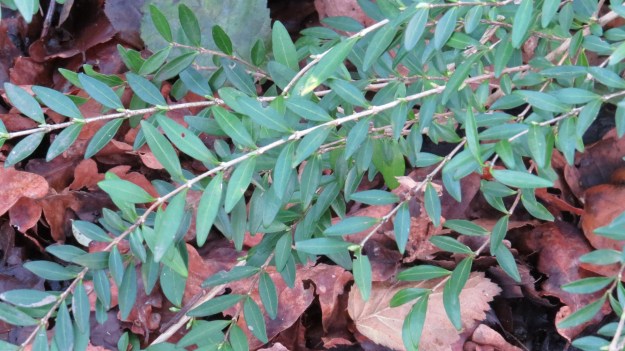Every Wednesday, I hope to find a new ‘weed’ to investigate. My only criterion will be that I will not have deliberately planted the subject of our inquiry. Who knows what we will find…..
Dear Readers, when I was in Coldfall Wood last week I found this plant lurking by the Everglades, a winter pond where the water level is now nearly up to the boardwalk.
 I must admit I was stumped. There is something a bit privet-like about it, but I had a feeling I’d seen the plant somewhere before.
I must admit I was stumped. There is something a bit privet-like about it, but I had a feeling I’d seen the plant somewhere before.
 And then I remembered. I’d seen it in supermarket car parks! A little research was in order and, with the aid of my botanist friends, I discovered that it was Box-Leaved Honeysuckle. It is being used in a lot of municipal planting to replace Box (Buxus sempervirens), as there is a lot of Box Blight about, a fungal disease which turns the leaves brown and leaves big bare patches. Members of the honeysuckle family are immune to Box Blight, and so have become very popular.
And then I remembered. I’d seen it in supermarket car parks! A little research was in order and, with the aid of my botanist friends, I discovered that it was Box-Leaved Honeysuckle. It is being used in a lot of municipal planting to replace Box (Buxus sempervirens), as there is a lot of Box Blight about, a fungal disease which turns the leaves brown and leaves big bare patches. Members of the honeysuckle family are immune to Box Blight, and so have become very popular.
Of course, this doesn’t explain what my plant is doing, bang-smack in the middle of a wood.
 We normally associate Honeysuckle with the golden-flowered climbing plant, spilling its scent into the warm summer air. But there are 180 species, of which over a hundred, including my plant, originated in China. Box-leaved Honeysuckle was brought to England in about 1900, and has been recorded ‘in the wild’ since about 1950. So this is a neophyte, a newbie, a brand new addition to our semi-wild flora.
We normally associate Honeysuckle with the golden-flowered climbing plant, spilling its scent into the warm summer air. But there are 180 species, of which over a hundred, including my plant, originated in China. Box-leaved Honeysuckle was brought to England in about 1900, and has been recorded ‘in the wild’ since about 1950. So this is a neophyte, a newbie, a brand new addition to our semi-wild flora.
‘If I were you, I’d dig it up’ said one of my botanical correspondents.

Box-leaved Honeysuckle in flower (“Lonicera pileata flowers 001” by User:SB_Johnny – Self-photographed. Licensed under CC BY-SA 3.0 via Wikimedia Commons )
But here I have a problem. This is an urban wood, surrounded by gardens, allotments and a cemetery. If I start digging up all the plants that aren’t native, I will need a veritable army of minions with spades to help me. There’s the cherry laurel, the horse chestnuts (well, they’re Roman), the sycamores, the stray pyracantha and even, hidden away, a teeny-tiny monkey puzzle tree. Plus, it would be a battle against overwhelming odds, as new plants are ‘jumping over the fence’ all the time. Finally, with climate change, everything is up for grabs. Plants that used to thrive are likely to start having problems. Plants that used to struggle may seize their moment. Each will bring opportunities and challenges for the creatures that rely on them.
Box-leaved Honeysuckle has several things in its favour. It provides cover for a variety of birds and small mammals, and is planted as such for game birds in some parts of the country. No less than 347 species of butterflies and moths worldwide feed on the leaves of the different Honeysuckle species, and the berries are popular with all kinds of thrushes (which probably explains how my plant got to this spot in the wood). Am I going to reject this largesse on the grounds that the plant is in the wrong place?

The berries are located on the underside of the branches, and so are very easy to miss! Thanks to the wonderful Landscape Architects’ website (https://davisla.wordpress.com)
It would be different, I think, if Coldfall Wood was that rarest of things, a pristine environment, or if Box-leaved Honeysuckle really presented some kind of threat to the ecology of the wood. But my guess is that it will enhance, rather than detract from, the biodiversity of the area. I look forward to seeing if it will flower, in spite of the deep shade, and if it will produce berries. It seems something of a free spirit, relaxing under a hornbeam tree instead of being blasted with diesel fumes in a supermarket car park. I find myself wishing it luck.

The Woodpecker you posted ex Jason Thomsen Flickr is in fact a ‘Middle Spotted Woodpecker’ The Great spottedc woodpecker does not ever have a Red crown but a Red spot below the headMale only.
Stormlizard Flickr. Name John.
Hi John, thanks for the comment – what post are you referring to? There isn’t a woodpecker on this one….
Pingback: Wednesday Weed – Winter Honeysuckle | Bug Woman – Adventures in London